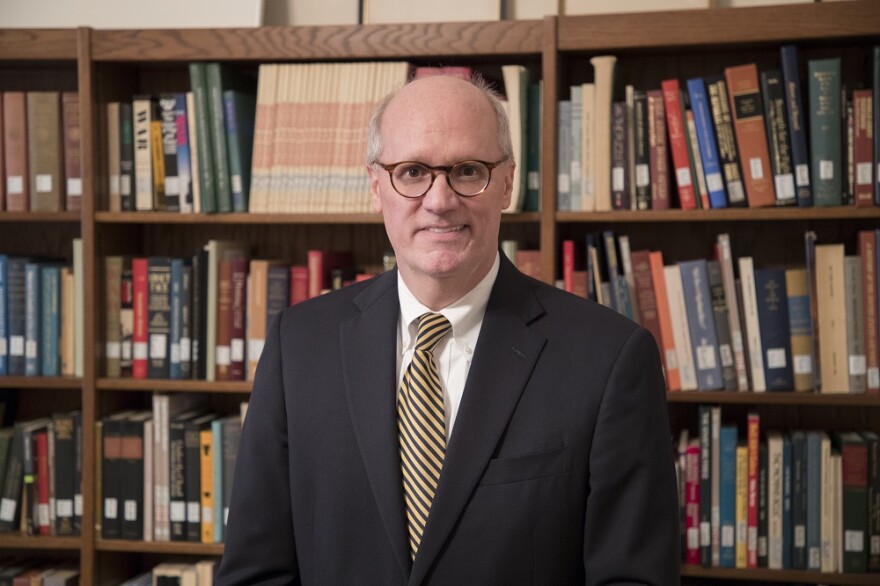Murray State's interim president says the university has to reach the "right size" with regard to enrollment to preserve its identity. Bob Jackson is in his second week in his new role and one of his challenges is to turn around declining enrollment. At a Chamber of Commerce breakfast with business leaders in Murray on Tuesday, Jackson outlined outreach opportunities and called on the community to help.
Jackson said he has put forth an effort to "move the needle" to 10,000 students by Fall 2019 and 10,500 by Fall 2020. The latter, he says, is closer to Murray State's "right size."
"I think it's somewhere between 10,500 and 10,950 in order to protect and preserve who we are and what we are and what we've been for a long time: that personal touch, that student-centered focus," he said.
Jackson said Murray State is not like "big institutions" such as Western Kentucky University, which has around 20,000 students. "Murray State University is a different place. We're primarily an undergraduate institution with some wonderful graduate programs. That's our core. That's our focus. That's our mission. That's where we will be."
He indicated that fall enrollment this year is under 10,000. Director of Communication Shawn Touney told WKMS News in a follow-up, would not provide a preliminary estimate and said it's "too early at this time." Final numbers are expected to be released in October. Total enrollment as of Spring 2018 was 8,637 - according to the June Board of Regents meeting. (More about recent enrollment efforts -- More MSU enrollment numbers)
Outlining opportunities, Jackson said part of the effort includes greater focus and attention on surrounding metro areas such as St. Louis, Nashville, Evansville and Indiana. "I think there's a greater opporunity we can take advantage of in the metro Louisville area. There's multi-counties. There's more than a million people there and we're probably not getting our fair share," he said. He also described increasing efforts to reach students in southern Illinois, south of I-64.
Jackson said he is looking to bolster market-share in Murray State's 18-county service region to at least 20% in each county. He said the market-share in Calloway County is around 70% and noted potential to grow in other counties, where the market-share in some is the single-digits. He discussed expanding opportunities in the regional campuses in Paducah, Henderson, Madisonville, Hopkinsville and Fort Campbell, particularly with non-traditional and military students.
Looking to the east of the 18-county service region, Jackson said recruiters will spend more time in Daviess County and to the south.
In responding to enrollment challenges, Jackson said the university will continue to look for opportunities and to respond. "It's why we're here. We're here for one reason and one reason only: it's teaching and learning. And our students are at the center and core of that so we've got to get them here and we've got to make sure we keep them here."
On recruitment, Jackson said the Road Scholars program involves faculty, staff, alumni and community members having a presence in local schools. He said the program was previously called 'Racer Round-Up' and 'In Search of Thoroughbreds.' The program was eliminated a few years ago in a cost-cutting measure but was re-launched last week. He said so far more than 150 individuals are involved in targeting 100 high schools for student recruitment. Jackson previously led the Murray State University Foundation. He said the Foundation has received private funding to enhance the road scholars program, including helping school districts pay for buses to come to campus. "The number one determinate of a student enrolling at your university is getting them on campus," he said.
Jackson also called on community members and business leaders to put Murray State posters in windows and storefronts and to wear Blue and Gold on Fridays, when most prospective students come to campus.
Former president Bob Davies said in a town hall meeting last Spring the university is becoming "privatized," meaning increasingly reliant on enrollment and tuition revenue. Prior to Davies' departure this month, the MSU Board of Regents had tasked him with finding ways to increase revenue and to reallocate his time to focus more on enrollment.
Kentucky public higher ed institutions have weathered in recent years multiple budget cuts, declining state appropriation, rising pension costs, performance funding competition and low morale.
According to the National Center for Education Statistics, undergraduate enrollment saw a 7% decline between 2010 and 2016. That followed a 37% increase in the decade prior. Undergraduate enrollment is projected to increase by 3% between 2016 and 2027. Postbaccalaureate enrollment (master's and doctoral degrees) is expected to increase by the same percentage over the same time period.





